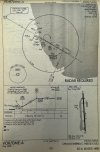Terry M - 3CK (Chicago)
Line Up and Wait
Been discussing IR training based at an airport with no approaches.
One suggestion was fly the approach at nearby delta KDPA breakout and get SVFR back to home drone.
I noticed today that KDPA was reporting MVFR. 10SM BKN 013 BKN 037 OVC somewhere higher.
But DPA is in congested airspace. So even though we had visibility, don't you need at least 1,500 to be VFR? 1,000 over congested area and 500 below the clouds?
I memorized 1,000 feet and 3 for VFR decades ago, but I've never flown it. Is that even legal?
One suggestion was fly the approach at nearby delta KDPA breakout and get SVFR back to home drone.
I noticed today that KDPA was reporting MVFR. 10SM BKN 013 BKN 037 OVC somewhere higher.
But DPA is in congested airspace. So even though we had visibility, don't you need at least 1,500 to be VFR? 1,000 over congested area and 500 below the clouds?
I memorized 1,000 feet and 3 for VFR decades ago, but I've never flown it. Is that even legal?

